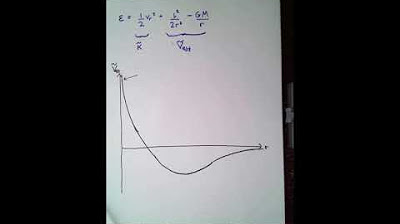Graphing Energy (VPython for Physics 1)
Summary
TLDRThis video explains the concepts of energy and forces in physics, focusing on how they interact during motion. It covers the use of the update procedure to simulate momentum and position in an animated system, highlighting the importance of conservation of energy. The video demonstrates the calculation of kinetic energy, potential energy, and total energy in a system, using code to visualize these energies. It also discusses the role of drag force, showing how non-conservative forces affect the energy system and how work done by these forces is tracked. This provides a practical approach to learning mechanics through simulation.
Takeaways
- 😀 Energy is a conserved quantity in physics, and its conservation is essential for accurate simulations.
- 😀 Kinetic energy depends on an object's mass and velocity, calculated as KE = 1/2 * m * v².
- 😀 Potential energy (PE) is related to the object's position in a gravitational field, with the formula PE = m * g * y.
- 😀 Total mechanical energy is the sum of kinetic and potential energy and should remain constant in an ideal system.
- 😀 Forces are essential for understanding motion, and energy provides an additional perspective, especially in the presence of non-conservative forces.
- 😀 Drag forces (air resistance) are non-conservative and cause a loss in the system's total energy.
- 😀 The work-energy principle states that the change in a system's energy equals the work done by or on the system.
- 😀 The Python code in the video tracks and visualizes energy changes by calculating kinetic energy, potential energy, and total energy over time.
- 😀 The introduction of drag forces into the simulation results in the loss of energy, visible in the decreasing total energy curve.
- 😀 Graphing energy curves (kinetic, potential, and total) helps visualize how energy changes during motion and shows the conservation of energy.
Q & A
What is the purpose of the update procedure in animating motion?
-The update procedure is used to animate motion by updating an object's momentum and position based on the forces acting on it. Momentum is updated using the net force, and position is updated by dividing the momentum by mass.
How is momentum updated in the animation process?
-Momentum is updated by multiplying the net force by the time step (delta T). This reflects how the object's momentum changes due to the forces acting on it over each time step.
What is the significance of delta T in the simulation?
-Delta T represents the time window for each step in the animation. It determines how often the object's momentum and position are updated in the simulation, creating a smooth representation of motion.
What is kinetic energy and how is it calculated?
-Kinetic energy is the energy associated with the motion of an object. It is calculated using the formula KE = 0.5 * mass * velocity^2, where mass is the object's mass and velocity is the magnitude of its velocity.
Why does kinetic energy only depend on the speed of an object and not its direction?
-Kinetic energy is a scalar quantity, meaning it only depends on the magnitude of velocity (speed) and not the direction. This is why kinetic energy cannot be negative and only reflects how fast the object is moving.
What is the difference between kinetic energy and potential energy?
-Kinetic energy is associated with the motion of an object, while potential energy is stored energy related to an object's position in a force field, such as gravity. For example, gravitational potential energy near Earth is calculated as PE = mass * gravity * height.
How can you visualize kinetic and potential energy over time in the simulation?
-You can visualize kinetic and potential energy over time by creating a graph that plots the kinetic energy and potential energy values against time. This allows you to see how they change and relate to each other throughout the simulation.
How is total energy conserved in the simulation?
-Total energy is conserved by ensuring that the sum of kinetic and potential energy remains constant over time. As one energy type decreases, the other increases, maintaining the overall energy balance.
What is the role of non-conservative forces, such as drag, in energy conservation?
-Non-conservative forces, like drag (air resistance), take energy away from the system. This results in a decrease in total energy, as the energy lost to drag is dissipated into the surrounding environment.
How is work done by drag calculated in the simulation?
-Work done by drag is calculated as the dot product of the drag force and the change in position (displacement) of the object. This work is negative because drag always opposes the object's motion, resulting in energy being taken away from the system.
Outlines

This section is available to paid users only. Please upgrade to access this part.
Upgrade NowMindmap

This section is available to paid users only. Please upgrade to access this part.
Upgrade NowKeywords

This section is available to paid users only. Please upgrade to access this part.
Upgrade NowHighlights

This section is available to paid users only. Please upgrade to access this part.
Upgrade NowTranscripts

This section is available to paid users only. Please upgrade to access this part.
Upgrade NowBrowse More Related Video
5.0 / 5 (0 votes)





